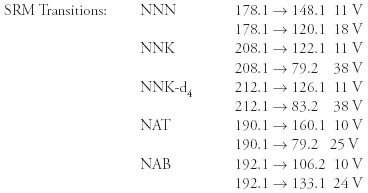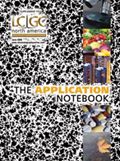Robust and Fast Analysis of Four Tobacco Specific Nitrosamines in Tobacco Cigarettes by LC–MS-MS Using RSLC PA2 Column
The Application Notebook
Tobacco Specific Nitrosamines (TSNA) are a group of carcinogens found only in tobacco products and are formed from nicotine and related alkaloids during the production and processing of tobacco and tobacco products (1). Due to their carcinogenic properties, efforts have been made to reduce TSNA levels in tobacco products. The project goal was to demonstrate a high throughput and sensitive method to monitor TSNA levels.
Tobacco Specific Nitrosamines (TSNA) are a group of carcinogens found only in tobacco products and are formed from nicotine and related alkaloids during the production and processing of tobacco and tobacco products (1). Due to their carcinogenic properties, efforts have been made to reduce TSNA levels in tobacco products. The project goal was to demonstrate a high throughput and sensitive method to monitor TSNA levels.
Conventional methods for TSNA analysis are based on gas chromatography with thermo energy analyzer (GC-TEA) (2,3,) or high performance liquid chromatography (HPLC) with various detection techniques, such as UV and mass spectrometry (MS) (4-6). This application note describes a robust and fast LC–MS-MS method for the determination of four TSNAs in tobacco cigarettes.

Figure 1
Experimental
Chromatographic Conditions
Analytical Column: Acclaim® RSLC PA2 (5.0 × 2.1 mm, 2.2 μm)
Column Temperature: 60 °C
Injection Volume: 10 μL
Mobile Phase: 10% CH3CN in buffer (1 mM NH4OAc, pH adjusted to pH 8.0 by NH4OH)
Flow Rate: 0.50 mL/min
Detection: UV @ 230 nm TSQ Quantum Access™ SRM with H-ESI
Mass Spectrometric Conditions
See Figure 1.

The first SRM transition of each compound is used for quantification and the second SRM transition is used for confirmation.
NNN: N'-nitrosonornicotine, NAT: N'-nitrosoanatabine, NAB: N-nitrosoanabasine. NNK: 4-(methylnitrosamino)-1-(3-pyridyl)-1-butanone.
Method Performance
Figure 1 shows the four TSNAs retained and completely resolved within 3.5 min, with the minimum of the retention factors (K'NNN) being greater than four and minimum resolution (RsNAT) greater than two. Demonstrated retention factors ensure the chromatographic separation of analytes of interest from early eluted compounds, which minimizes the possibility of ionization suppression and eliminates cross contamination of SRM transitions between main analytes. The use of specific MS-MS detection allows the simplification of sample preparation, and the greater sensitivity ensures quantification confidence at low levels.
Since the analytical column was running under the very harsh conditions of high temperature and high pH mobile phase, method ruggedness was evaluated by repeated injections of standard solutions and tobacco extracts and was well maintained after more than 1000 injections.
Conclusion
A simple, sensitive, and specific method for the determination of tobacco specific nitrosamines is demonstrated and has been applied to the analysis of TSNAs in different cigarettes.
References
(1) Hecht, S. S.; Hoffmann, D. Carcinogenesis 1988, 9, 875–884.
(2) Adams, J. D.; Brunnemann, K. D.; Hoffmann, D. J.Chromatog.,A 1983, 256, 347–351.
(3) Krull, I. S.; Swartz, M.; Hilliard, R.; Xie, K. H.; Driscoll, J. N. J. Chromatog., A 1983, 260, 347–362.
(4) Wu, W.; Ashley, D. L.; Watson, C. H. Anal. Chem. 2003, 75, 4827–4832.
(5) Wagner, K. A.; Finkel, N. H.; Fossett, J. E.; Gillman, I. G. Anal. Chem. 2005, 77, 1001–1006.
(6) Wu, J.; Joza, P.; Sharifi, M.; Rickert, W. S.; Lauterbach, J. H. Anal. Chem. 2008, 80, 1341–1345.
TSQ Quantum Access is a trademark of Thermo Fisher Scientific. All other trademarks are the property of Dionex Corporation.

Dionex Corporation
1228 Titan Way, P.O. Box 3603, Sunnyvale, CA 94088-3603
tel. (408)737-0700, fax (408)730-9403
Website: www.dionex.com

Free Poster: NDSRI Risk Assessment and Trace-Level Analysis of N-Nitrosamines
April 25th 2025With increasing concern over genotoxic nitrosamine contaminants, regulatory bodies like the FDA and EMA have introduced strict guidelines following several high-profile drug recalls. This poster showcases a case study where LGC and Waters developed a UPLC/MS/MS method for quantifying trace levels of N-nitroso-sertraline in sertraline using Waters mass spectrometry and LGC reference standards.
New TRC Facility Accelerates Innovation and Delivery
April 25th 2025We’ve expanded our capabilities with a state-of-the-art, 200,000 sq ft TRC facility in Toronto, completed in 2024 and staffed by over 100 PhD- and MSc-level scientists. This investment enables the development of more innovative compounds, a broader catalogue and custom offering, and streamlined operations for faster delivery. • Our extensive range of over 100,000 high-quality research chemicals—including APIs, metabolites, and impurities in both native and stable isotope-labelled forms—provides essential tools for uncovering molecular disease mechanisms and exploring new opportunities for therapeutic intervention.
New Guide: Characterising Impurity Standards – What Defines “Good Enough?”
April 25th 2025Impurity reference standards (IRSs) are essential for accurately identifying and quantifying impurities in pharmaceutical development and manufacturing. Yet, with limited regulatory guidance on how much characterisation is truly required for different applications, selecting the right standard can be challenging. To help, LGC has developed a new interactive multimedia guide, packed with expert insights to support your decision-making and give you greater confidence when choosing the right IRS for your specific needs.
Using the Carcinogenic Potency Categorisation Approach (CPCA) to Classify N-nitrosamine Impurities
April 25th 2025Learn how to manage nitrosamine impurities in pharmaceuticals with our free infographic. Discover how the CPCA approach establishes acceptable intake limits and guides the selection of NDSRI reference samples. Stay compliant and ensure safety with our ISO-accredited standards.

.png&w=3840&q=75)

.png&w=3840&q=75)



.png&w=3840&q=75)



.png&w=3840&q=75)














